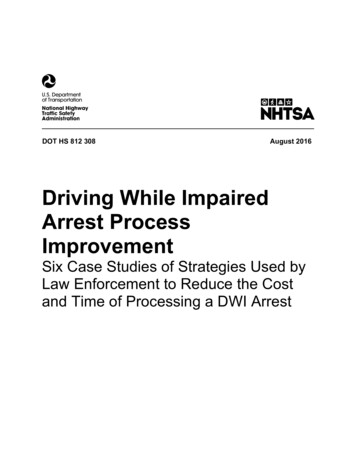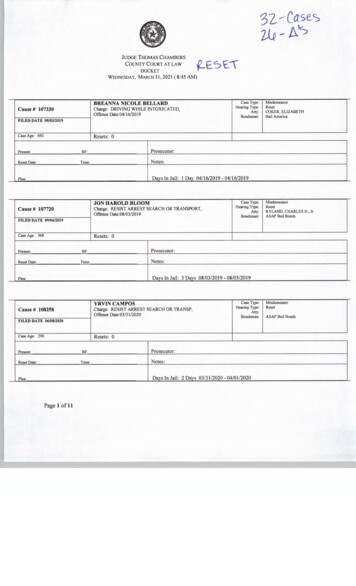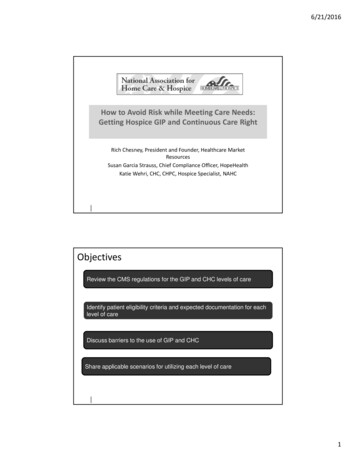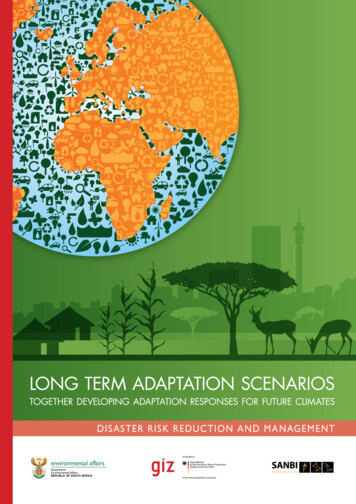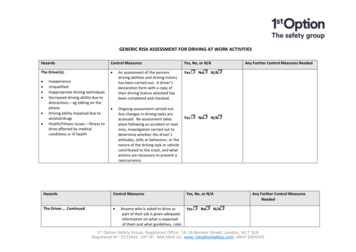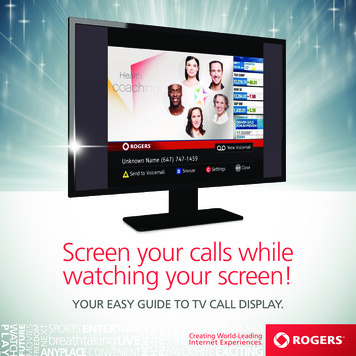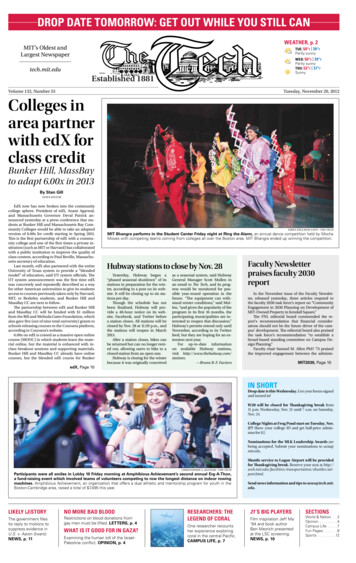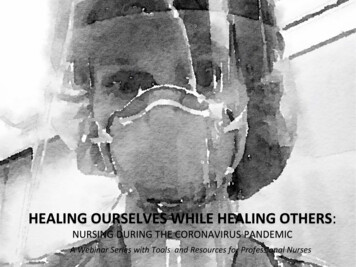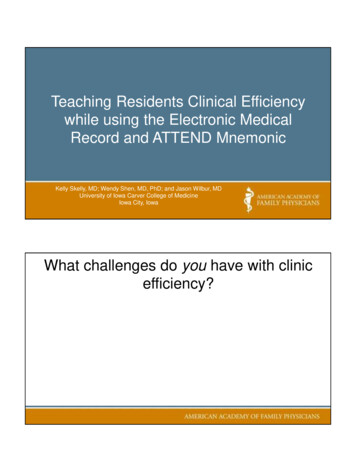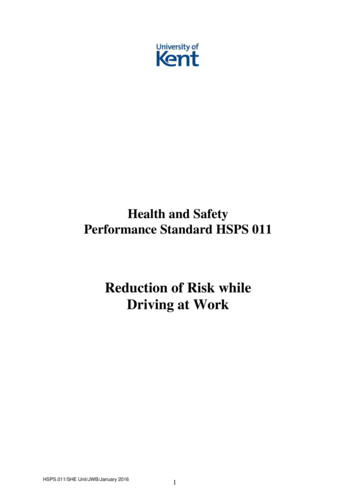
Transcription
Health and SafetyPerformance Standard HSPS 011Reduction of Risk whileDriving at WorkHSPS.011/SHE Unit/JWB/January 20161
Safety, Health and Environment UnitTitleReduction of Risk while Driving at WorkReferenceNumberHSPS 011DOCUMENT HISTORYIssueDateDetails128.10.2008Submitted to SHEEC 28 October 2008217.02.2009Submitted to SHEEC 17 February 2009320.02.2009Revised by SHEEC401.05.2009Issued519.01 2016RevisedAuthorJim BloorSignatureDate 19 Jan 2016ReviewerBernard AngusSignatureDate 19 Jan 2016Issued bySHE UnitSignatureDate Jan 2016HSPS.011/SHE Unit/JWB/January 20162
ContentsPage1. Introduction42. Driving University Vehicles43. Health Screening for Drivers of University Vehicles54. Driving Private Vehicles55. Driving Abroad66. Driving Licence Checks6Appendix ACorporate Risk Assessment7Appendix BIndividual Driver Risk Assessment FormIndividual Driver Risk Assessment - Guidance1112Appendix CDriving on University business – key pointsto remember13HSPS.011/SHE Unit/JWB/January 20163
1. IntroductionOver 1700 people are killed on British roads each year. Of these deaths around 100 arepeople who are driving for work and over 400 are people killed in accidents involving thosedriving for work. With regard to our own safety and that of others, driving is likely to be themost dangerous work activity that most of us do. Health and Safety law applies to all workrelated activities and driving is no exception. As an employer the University has a duty tomanage the risks that stem from driving activities undertaken on its behalf.Driving for work includes all journeys undertaken as part of your job, including all workrelated journeys undertaken in your own car. The only exception to this is your normalcommute from home to work and back. Examples of driving for work include all journeys inUniversity vehicles, driving a hire car to a conference in the UK or abroad, driving your owncar or motorbike between campuses or from home to a campus different to that where younormally work, driving to an off-campus meeting or even just popping out to pick upsomething needed for work.The University expects all members of staff who drive on its business to do so safely andlegally. They must possess a valid driving licence; comply with all applicable regulationsunder the Road Traffic Act; obey national driving-related drug and alcohol legislation, as wellas that regarding the use of mobile phones while driving. They must be properly insured andshould follow the Highway Code. They should be familiar with the generic driving for workrisk assessment found in Appendix A and, where applicable, abide by its recommendations.2. Driving University VehiclesAll drivers of University vehicles must be authorised to do so under the University’sinsurance policy and must complete the appropriate Authorisation Questionnaire found on theInsurance Office website. If there is a change in the category of University vehicle whichauthorised drivers use, managers should check via the DVLA that the individual’s drivinglicence is valid for the new vehicle category and with the University’s Insurance Office toensure that the current driver authorisation is still valid.All authorised drivers must also be subject to an Individual Driver Risk Assessment (IDRA).This should be carried out by individual drivers and reviewed by the appropriate line manageror manager responsible for the vehicle. The risk assessment protocol, together withassociated advice, can be found in Appendix B. To ensure that an appropriate driving licenceis held and to check that information provided regarding licence endorsements is correct,managers must also undertake an initial Driver’s Licence check. The protocol for doing so isdetailed at the end of this document.Changes to the information required for the Driver Authorisation and IDRA, i.e. changes inmedical fitness to drive, licence endorsements or involvement in a motor vehicle accident,must be supplied by the employee to the appropriate manager. In the case of endorsementsand accidents this is regardless of whether they occurred while driving for work or whiledriving in a private capacity. The manager should provide this information to the InsuranceHSPS.011/SHE Unit/JWB/January 20164
Office and update the IDRA. To ensure that this takes place, Departments and Schools thatpossess University vehicles should repeat Driving licence checks for authorised drivers on anannual basis. It is advised that this should be done in conjunction with RPD, as it is expectedthat driving and the IDRA would form part of that discussion, or for those Schools orDepartments that require staff to resubmit Authorisation Questionnaires on an annual basis, inconjunction with that activity. It should be noted that, with the exception of a disqualificationfrom driving, involvement in a motor vehicle accident or licence endorsements are unlikely toresult in the withdrawal of driver authorisation.3. Health Screening for Drivers of University VehiclesAll drivers of University vehicles are required to undertake health screening carried out byOccupational Health. This entails discussion of the individual’s medical history includingany medication taken regularly, a simple vision test and a blood pressure test, together withmeasurement of height and weight. The purpose of this screening is to ensure that those whodrive University vehicles meet the driving fitness standards required of all drivers by theDVLA. If an individual fails the vision or blood pressure test they will be referred to theirGP or optician to have the problem addressed. They will not be fit to drive until a follow upscreen in OH shows that their fitness is in line with necessary standards. NB: It should beemphasised that there is no intent to permanently remove staff from their role driving at workas any adverse findings should be quickly and easily resolved by referral to the appropriateagency. This screening is solely aimed at ensuring that all authorised drivers are safe to drivein line with recognised health standards4. Driving Private VehiclesMuch of the risk associated with driving on behalf of the University comes from individualsdriving their own vehicles. Members of staff driving their own private vehicle for workpurposes are responsible for ensuring that that vehicle is road-worthy. Simple steps to take toensure road-worthiness include a) possession of a valid MOT certificate where it is legallyrequired, b) ensuring that the vehicle is serviced regularly and c) carrying out standard vehiclemaintenance checks on a regular basis, i.e. checking tyre pressures, checking engine fluidlevels, ensuring windscreen wipers are functional and effective, checking brakes, checkingseat belts, etc.Staff must also possess the correct insurance cover. Any journey undertaken for work,however trivial, requires vehicle insurance that covers business use. This is a legalrequirement. Driving for work without appropriate business insurance is considered the sameas driving without insurance, a motoring offence that attracts at least 6 penalty points and afixed penalty fine payable by the driver. If in doubt as to whether a journey constitutesbusiness use, staff should consult their insurance company for clarification.University employees who drive their own vehicle for work and whose contracts or jobdescriptions require them to drive or to hold a driving licence should be subject to IndividualDriver Risk Assessments (Appendix B) carried out by their line manager. Equally, theyshould be carried out where it has become an accepted management expectation that aHSPS.011/SHE Unit/JWB/January 20165
member of staff will undertake regular and frequent trips in their own private vehicle. (Note IDRA’s are not required for staff who simply make a personal choice to drive their ownvehicles for work purposes). Changes to the information required for the IDRA, such aslicence endorsements or involvement in a motor vehicle accident must be provided to the linemanager who should then update the IDRA. To ensure that this takes place, the drivinglicences of these drivers should be checked on an annual basis. IDRA’s should be discussedat RPD meetings.Such drivers should also inform their line manager of any change in medical fitness to drive.If there are concerns over medical fitness to drive these individuals should be referred toOccupational Health.5. Driving AbroadAny employee who drives abroad on University business must ensure that they comply withthe laws of that country, carry all appropriate equipment and documentation with them andare competent and confident about driving in the country in question.6. Driving Licence ChecksThe DVLA no longer issues paper counterparts to the photo-card driving licence. Licencesnow have to be checked online. Drivers should go to https://www.gov.uk/view-drivinglicence and enter the requested details (driving licence number, national insurance numberand home postcode). Click on the ‘Share your licence information’ button and then the ‘Get aCode’ button to generate a licence check code. This should be given to the appropriatemanager together with the last 8 characters of that individual’s driving licence number.Managers should go to https://www.gov.uk/check-driving-information to view the individuallicence details. A copy should be printed out to keep on record. This should be retained untilthe subsequent annual check is carried out or the individual stops driving on Universitybusiness at which point it should be securely destroyed.Individuals with a non-GB licence should have their eligibility to drive in the UK checked 11/SHE Unit/JWB/January 20166
Sheet No: 1/4Appendix ACORPORATE ROAD RISK ASSESSMENTHAZARD(List)PERSONS AT RISK AND HOW(Consider all persons, including thosewho may not be involved with the job)EXISTING CONTROL MEASURESAND ADEQUACY(List the control measures appropriateto each hazard and consider the levelof residual risk; is it high, medium orlow?)ADDITIONAL REQUIREMENTS(If the residual risk is high, you musttake additional practicable measuresto reduce it, or abort the proposedtask)Employee driving at excess speedUoK EmployeesPublicWorst Outcome - Multiple FatalityEmployees always to drive within legalspeed limits and at a speed that issafe for the prevailing road conditions.Obey temporary speed limits.Annual licence checks for drivers ofUniversity vehicles and those expectedto drive on University business tocheck for speeding endorsements.Advice given to drivers with multiplespeeding penaltiesOther road users driving at excessspeedUoK EmployeesWorst Outcome - Multiple FatalityEmployees to be vigilant regardingother road users. When parking, do soin a safe area and maintain awarenessof other road users when opening cardoors.Distractions whilst DrivingUoK EmployeesPublicWorst Outcome - Multiple FatalityDrivers are NOT to use two wayradios or mobile telephones,including ‘hands free’ equipment.Care to be taken when using in carmusic and satellite navigation systemsAggression from other road users(“Road rage”)UoK EmployeesWorst Outcome - Multiple FatalityAvoid confrontational situations withother drivers. If available, carry amobile phone. If threatened stay in thecar, lock doors, keep windows shutand phone police. Put on headlightsand hazard lights, sound horn toattract assistance.HSPS.011/SHE Unit/JWB/January 20167If under immediate threat fromviolence be prepared to shield yourself from broken glass using a coat,etc. If possible note down theoffender’s vehicle type and registrationnumber.
Sheet No: 2/4Appendix ACORPORATE ROAD RISK ASSESSMENTHAZARD(List)PERSONS AT RISK AND HOW(Consider all persons, including thosewho may not be involved with the job)EXISTING CONTROL MEASURESAND ADEQUACY(List the control measures appropriateto each hazard and consider the levelof residual risk; is it high, medium orlow?)ADDITIONAL REQUIREMENTS(If the residual risk is high, you musttake additional practicable measuresto reduce it, or abort the proposedtask)Adverse weather (fog, snow and ice,heavy rain)UoK EmployeesPublicWorst Outcome - Multiple FatalityDrivers to reduce speed to thatappropriate for the conditions and tomaintain safe braking distance fromvehicles in front. Exercise carefuldeliberate manoeuvres, with nosudden changes in speed or direction.In fog, drive with dipped headlightsand fog lights.In the event that driving visibilitybecomes seriously impaired due tovery heavy rain or fog, find a safeplace to stop and wait for conditions toimprove. Use hazard lights whenstopped.Monitor weather reports before andduring the journey. Consider delayingtravel or rescheduling. If available,carry a mobile telephone and maintainregular contact with the office.If conditions persist (fog, snow andice) find somewhere safe to wait outthe conditions, including an overnightstay in necessary.On long journeys drivers shouldensure they are adequately rested andshould share driving if at all possible.Drivers to stop to rest at the first signsof fatigue. In addition, planned restbreaks should be taken at a maximumof two hour intervals.Do not drink alcohol before orduring the journeyDriver FatigueUoK EmployeesPublicWorst Outcome - Multiple FatalityAvoid medications which inducetiredness and only take prescribeddrugs in accordance with doctor’sinstructions.HSPS.011/SHE Unit/JWB/January 20168No other drugs
Sheet No: 3/4Appendix ACORPORATE ROAD RISK ASSESSMENTHAZARD(List)PERSONS AT RISK AND HOW(Consider all persons, including thosewho may not be involved with the job)EXISTING CONTROL MEASURESAND ADEQUACY(List the control measures appropriateto each hazard and consider the levelof residual risk; is it high, medium orlow?)Road Works/Temporary surfacesUoK EmployeesPublicRoad Works Contractors’ EmployeesWorst Outcome - Multiple FatalityDrivers to proceed with caution atappropriate speed. Observe all trafficspeed limits and controls. Be vigilantfor roadside operatives. If directed intodangerous situations, due to faultycontrols etc., use hazard lights.Reversing VehiclesUoK EmployeePublicWorst Outcome - Multiple FatalityIn confined spaces or poor visibilityconditions, use passenger if availableto act as lookout or banksman,standing to rear and side of vehicle(always in view of driver). If unsureleave vehicle to look behind for smallchildren etc.Ensure reversing lights are workingand all mirrors are serviceable.UoK EmployeePublicWorst Outcome - Multiple FatalityDrivers should familiarise themselveswith the controls of any unfamiliarvehicleUnfamiliar vehicle controlsHSPS.011/SHE Unit/JWB/January 20169ADDITIONAL REQUIREMENTS(If the residual risk is high, you musttake additional practicable measuresto reduce it, or abort the proposedtask)In addition:For all vans, trucks, lorries, etc,always use banksman. Driver tostop immediately, if visual contactis lost with banksman. Wheredeemed necessary vehicles to befitted with audio reversingindication device.
Sheet No: 4/4Appendix ACORPORATE ROAD RISK ASSESSMENTHAZARD(List)PERSONS AT RISK AND HOW(Consider all persons, including thosewho may not be involved with the job)EXISTING CONTROL MEASURESAND ADEQUACY(List the control measures appropriateto each hazard and consider the levelof residual risk; is it high, medium orlow?)Route PlanningUoK EmployeesPublicWorst Outcome - Multiple FatalityThe need for the journey should beconsidered, as well as whether it ispossible to travel by public transport.Journeys should be planned inadvance, taking into account likelytraffic congestion and road works,such that there is no need to drive atexcessive speed and appropriate restand welfare breaks can be taken.For complex and/or unfamiliar routesmaps should be taken or satellitenavigation systems used. Maps shouldonly be consulted when parked in asafe area. Sat Navs should beprogrammed prior to the journeycommencing and should not be reprogrammed when driving.HSPS.011/SHE Unit/JWB/January 201610ADDITIONAL REQUIREMENTS(If the residual risk is high, you musttake additional practicable measuresto reduce it, or abort the proposedtask)
Appendix B - Individual Driver Risk AssessmentRisk FactorScoreAge 252025-351035-605 6010 5 years205-10 years10 10 years5Total annual mileage 500010(work and private)5000-200005 2000020Total time spent driving each day 1 hour5(work and private)1-3 hours10 3 hours20Driving accidents in last 5 years00(regardless of fault)1102203 or more40None0Fixed penalty10Single speeding offence25Multiple speeding offences50Careless driving50Dangerous driving70Driving under the influenceof alcohol or drugs70Time licence heldDriving convictions /endorsements in last 5 yearsIndividualScoreTotal Score Risk AssessmentTotal PointsLow Risk 20 - 40Medium Risk 40 - 55High Risk 55 HSPS.011/SHE Unit/JWB/January 201611
Individual Driver Risk Assessment - GuidanceLine managers are expected to review the driving patterns of any individual who is categorisedas high risk. For example, a young, inexperienced driver who drives for a substantial time anddistance will be considered high risk. Unsurprising as such individuals are more likely to beinvolved in motor vehicle accidents. A review of their work driving patterns may consider thedistance and time spent driving for work and whether this should be reduced. Equally, anindividual with multiple speeding offences will be considered high risk. A review shouldconsider over what period of time these offences occurred. If they were condensed into a 12month period say, then this might be considered indicative of dangerous driving habits and itmay be necessary to remove that individual from driving duties. All decisions made on the basisthat individuals are classed as high risk are for the line manager to take, but advice can be soughtfrom Human Resources and the Safety, Health and Environment Unit.HSPS.011/SHE Unit/JWB/January 201612
Appendix CDriving on University business – Key Points to remember1. Is your journey by car absolutely necessary?2. Does someone know where you are going and when you expect to be back?3. Do you have a valid Driving Licence?4. Do you have car insurance and does it cover you to drive on your employer’sbusiness?Note If any of the questions 1-4 incl. has been answered with ‘No’ - Do not drive.5. Do not drive if you are taking prescribed medication and have been advisedthat it may affect your ability to drive safely.6. Do not drive if you have been drinking alcohol or taking drugs7. Do not drive if you are tired or unwell8. If you feel drowsy, pull over and take a break9. Never talk on a mobile phone when you are driving, even ‘hands free’. Pulloff the carriageway, turn off the engine to make calls or view your messages.10.Use appropriate lighting for the conditions11.Always drive within your capabilitiesHSPS.011/SHE Unit/JWB/January 201613
however trivial, requires vehicle insurance that covers business use. This is a legal requirement. Driving for work without appropriate business insurance is considered the same as driving without insurance, a motoring offence that attracts at least 6 penal
